Oat Production in North Dakota
(A891, Revised Sept. 2018)
This publication provide guidelines for producing oats in North Dakota. It includes recommendation on variety selection, disease and weed control and fertilizer management.
Joel Ransom, Extension Agronomist – Cereal Crops
Michael S. McMullen, Oat Breeder, Professor; Andrew Friskop, Extension Plant Pathologist – Cereal Diseases
Availability: Web only
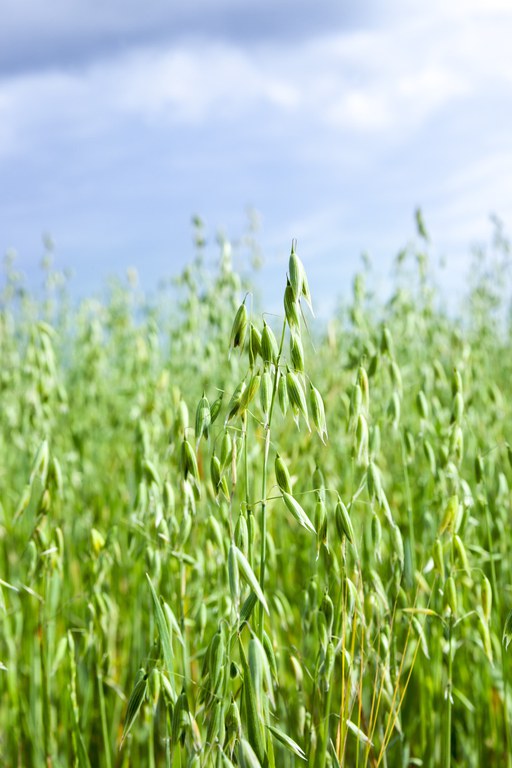
North Dakota is the leading producer of oats for grain in the U.S. However, the area planted to oats has been declining during the last three decades. Oats were grown on only 265,000 acres in North Dakota in 2018.
Typically, two-thirds of the oats planted are harvested for grain and the rest is grown primarily for forage/hay. Oats are grown in every county in North Dakota, with the major area of production in the southwestern quarter of the state.
Oats produced in North Dakota are generally of high quality, with good test weight and protein levels. Oats can be grown for the human food industry (milling), as an animal feed and for forage/hay.
Each market demands differing qualities. Knowing the market and using appropriate production practices and varieties are key to meeting the quality demanded by these diverse markets.
Quality Requirements of Milling Oats
Oats are used in a wide range of food products, with a growing application in specialty foods due to the health benefits of oat bran. The milling market maintains high-quality standards and prefers the following characteristics:
- High test weight (38 pounds/bushel or greater)
- Bright color
- High groat percent – Groat refers to the kernel after the hulls have been removed. Groat percentage is calculated by dividing the weight of the groat by the weight of the kernel before dehulling.
- Low oil content – Oil increases the caloric value of the product. High levels of oil cause caking in the milled product, which creates handling challenges.
- High protein – All varieties recommended for North Dakota under most production environments meet the minimum requirement for protein content.
- High beta glucan – Extensive research indicates oat soluble fiber consisting of beta glucan (β-glucan) in human diets is effective in lowering the serum cholesterol level, improving the ratio of HDL (good cholesterol) to LDL (bad cholesterol) and maintaining functions to moderate glucose metabolism in individuals with Type 2 diabetes.
Refer to the latest selection guide (Extension publication A1049) for the currently recommended varieties and their characteristics to assist you in selecting varieties that are best suited for the milling market.
Quality Requirements for Feed Uses
Oats are an excellent feed for sheep, hogs, dairy and beef cattle, and horses. With the exception of the racehorse market, the specifications for oats used for feed are less strict than those used for milling. Thus, yield becomes a dominant factor when selecting varieties for this market.
Nevertheless, the following are the preferred quality characteristics of feed oats:
- High test weight
- High oil content because this provides extra energy to the animal
- High protein content
Kernel quality characteristics of primary concern for the premium racehorse market include uniformly large kernels with bright, white hull color and very high test weight. Protein standards usually are met by all varieties even though higher protein content is desirable.
Refer to the latest selection guide (Extension publication A1049) for the currently recommended varieties and their characteristics to assist you in selecting varieties that are best suited for the racehorse market.
Quality Factors for Forage Uses
Forage quality largely is determined by its digestibility and crude protein content. Oat varieties can vary for these factors.
Total energy also is influenced by the yield and maturity at harvest. Later-maturing varieties generally are grown for forage because they tend to produce more biomass. Because comparative forage yield is not routinely available, a good rule of thumb is that varieties that produce the highest grain yield will produce the greatest forage yield.
Fitting Oats in the Crop Rotation
Oats can be a good crop to include in a rotation. Oats do best when they are grown following a noncereal crop such as soybeans, dry beans, potatoes, flax and canola. Oats also can be grown after corn because they are not as susceptible to Fusarium head blight (scab) as other small grains.
Oat stubble fields are excellent for establishing winter wheat no-till because they do not carry most diseases that affect wheat. Oats also can be grown after barley or wheat with limited risk of foliar diseases.
However, a small grain on a small grain system may increase the risk of root rots and Fusarium head blight. Furthermore, the best yields will be obtained when following a noncereal crop.
Variety Selection
The first consideration when selecting an oat variety is its intended use. Refer to the most recent variety selection guide for information from yield trials conducted throughout the state. This publication, “North Dakota Barley, Oat and Rye Variety Trial Results for 20XX and Selection Guide (A1049-XX), is available on the web. Additional yield trial information that was not included in this publication also may be available on
the same website.
When available, use data from multiple years and locations that are representative of the soil and weather on your farm when selecting a variety. Varieties that perform well in a range of environments have a higher probability of being more productive than those that do well in only a single year or environment. When comparing the yield of hull-less oat varieties with regular hulled types, add 35 percent to the weight of the hull-less types because the hulls make up that additional weight.
In addition to yield, consider quality characteristics such as test weight, protein, oil and grain color. If you are targeting markets that will return value to producers for increased nutritional quality, the β-glucan concentration also can be an important characteristic to consider.
Disease resistance, especially crown rust resistance, also should be considered. As new virulence develops in the crown rust populations, genetic resistance to specific races in specific varieties may be ineffective in providing resistance. Currently, very few oat varieties have resistance to the prevalent races of crown rust.
When selecting a variety for forage/hay, you may find additional information about the performance of a limited number of oat varieties.
We recommend certified seed when purchasing seed. Certified seed not only guarantees the levels of weed seed contaminates and germination; it also guarantees the genetic identity of the variety.
Planting
Date
Plant early. Oats respond positively to early planting and are adapted to cool seedbeds. Early planting enables more tiller production and larger panicles, and avoids high-temperature stress later in the season that can reduce seed size. Early planting may help you avoid diseases that develop late in the season.
The optimum period for planting is before May 15 in northern regions of the state and before the end of April in southern regions. In fields where wild oats are problematic, research has shown that wild oat severity can be reduced by planting after the first flush of wild oats have emerged and been controlled. However, this practice likely will result in yield reductions due to the effect of late planting.
Seeding Rate
For grain production, the recommended seeding rate is 1 million pure live seeds per acre (approximately 60 to 90 pounds/acre). Use a slightly higher rate if seeding deeply, late or into a rough seedbed. Higher seeding rates can offer improved competition with wild oats. However, excessive plant populations can reduce test weight and protein and increase lodging.
The percentage of seeds that germinate from hull-less oat varieties can be low because the embryo can be damaged easily during harvest and handling. Be sure to adjust for germination when calculating your seeding rate of hull-less oats. Because of the heavier bushel weight of hull-less types, the recommended seeding rate equates to 48 to 62 pounds/acre.
When seeding oats for forage, use a seeding rate similar to that used for grain. However, when oats are grown as a companion crop when establishing a perennial forage, use two-thirds of a normal seeding rate if seeding early and a full seeding rate if seeding late because tillering is less with later seedings.
Seeding Depth
Oats have the ability to emerge through elongation of the coleoptile and the first internode, resulting in the crown being closer to the surface of the soil than other small grains up to the three-leaf stage. The optimum seeding depth is 1.5 to 2.5 inches. When seeding depth approaches 3 inches,
Fertility Management
Nitrogen (N) and phosphorus (P) are the plant nutrients most often found to be deficient in this region. Fertilizer rates should be based on yield potential, a fall soil test and any expected N to be released from the previous crop. The basic recommendation for N is:
N recommendation (pounds N/acre) = 1.3 x YP – STN – PCC
YP = yield potential (bushels/acre) based on some historic average from the farm or area
STN = soil test nitrate-N (pounds N/acre) from a soil surface to 2-foot depth
PCC = previous crop credit (pounds N/acre) from annual/perennial legumes or sugar beet leaves
The previous crop credit (PCC) for annual legumes, including soybeans, dry beans, peas and lentils, is 40 pounds N/acre. The PCC for sugar beets varies with canopy color at harvest. See NDSU Extension publication SF882 (revised 2018) for more detailed information on suggested PCC values for sugar beets, alfalfa and sweetclover.
Selection of the N source should be based on cost, convenience, practicality, safety and availability. The placement and timing of application also are critical to achieving the highest efficiency possible for each product. If applied correctly, no difference occurs in the efficiency of any source of N.
Anhydrous ammonia should be applied 4 to 6 inches deep to reduce gaseous losses. If applied at seeding, the lateral distance between the center of the ammonia band and the seed furrow should be 3 inches.
Dry products broadcast on the soil surface should be incorporated shortly after their application. In no-till, subsurface applications of N are preferred to avoid large possible ammonia volatilization losses from urea.
Fall applications of N are usually as efficient as spring applications, except on sandy soils or soils subject to flooding. Some fall conditions with exceptionally warm weather would make fall applications less efficient than spring applications.
Fertilizers should not be applied to frozen soils. Urea-based fertilizers are very soluble, and spring runoff will carry the fertilizer off site if the soils are frozen. The amount of fertilizer placed with the seed should be limited. Rates of potassium and phosphorous are determined based on the yield potential of a field and the soil test values (see Table 1).

Sulfur deficiencies may occur on sandy soils or soils with low organic matter following higher than normal rainfall. No responses to micronutrients have been observed in North Dakota.
Weed Control
Oats can be competitive with weeds when properly managed. Fields infested with wild oats should be avoided because no registered herbicides can control wild oats selectively in an oat crop. A number of herbicides are registered for use in controlling broadleaf weeds.
Refer to the most recent edition of the “North Dakota Weed Control Guide” (W253) available from NDSU Extension for information on registered herbicides. Always refer to and follow the label of any product applied.
Wild oats are controlled most effectively by rotating with crops where wild oat control is possible. When growing oats, higher seeding rates (greater than 1 million seeds per acre) can help reduce the production of wild oat seeds. Late seeding after the first flush of wild oats has emerged and been controlled by a preplant burn-down also can be used to limit wild oat competition in fields where wild oats are known to be problematic. However, late planting can reduce yield significantly.
Disease Management
Several diseases can affect the yield and quality of oats. For the purposes of this publication, only the three most common diseases that affect yield are discussed in detail. They are crown rust, stem rust and barley yellow dwarf. Oats is a host for Fusarium head blight, but reports of it impacting production or quality in North Dakota have been infrequent.
Crown Rust (Puccinia coronata f. sp. avenae)
Crown rust is the most common and damaging oat disease in North Dakota.
The crown rust pathogen will not infect other small grains.
Unlike other cereal rusts, this pathogen overwinters in North Dakota and can lead to early disease onset. Additional spore sources are carried into the state by southerly winds.
- Warm weather (65 to 80 F) and frequent leaf moisture events (dew, fog and rain) favor disease development.
- Pustules are oval to oblong and contain orange-yellow spores (Figure 1a).
- Pustules are found on leaves (most common), stems and glumes.
- Eventually, orange-yellow spores will convert to black spores and overwinter (Figure 1b).
- Host resistance is the preferred management tool, but the pathogen has many races that overcome host resistance.
- Fungicides (several labeled chemistries) are an effective management tool and are best applied at the flag leaf growth stage. Updated information can be found in the “North Dakota Plant Disease Management Guide” (PP622).
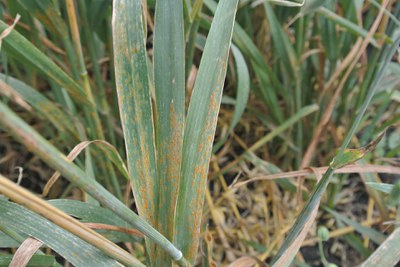
A
|
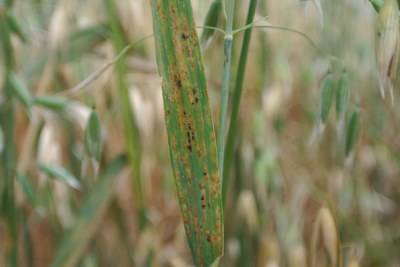
B
|
Figure 1. (A) Crown rust pustules with orange-yellow spores. (B) Orange-yellow pustules along with black overwintering structures. (Andrew Friskop, NDSU)
Stem Rust (Puccinia graminis f. sp. avenae)
- Stem rust is observed in North Dakota infrequently.
- It does not cause stem rust of wheat or barley.
- It does not overwinter in North Dakota, and relies on southerly winds to blow spores into the state.
- Warm weather (68 to 80 F) and frequent moisture events (dew, fog and rain) favor disease development.
- Pustules are irregularly shaped and contain dark red-brown spores (Figure 2).
- Noticeable tearing of the stem is observed with stem rust pustules. Pustules also can occur on the leaf.
- Management primarily is accomplished by using resistant varieties (very few races).
- If needed, fungicides at the flag leaf stage can reduce yield and quality losses. The same fungicide(s) used for crown rust also will be effective for stem rust.
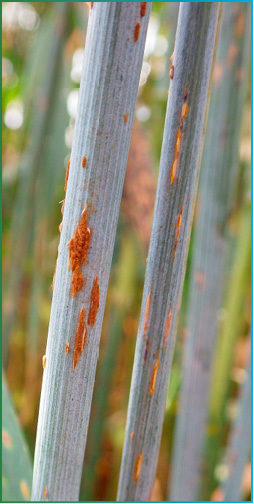
Figure 2. (Left) Stem rust pustules with dark red-brown spores. (Right) Crown rust pustules on stem. Note color and size differences. (Andrew Friskop, NDSU)
Barley Yellow Dwarf (Barley yellow dwarf virus and Cereal yellow dwarf virus)
- It is vectored by several species of cereal aphids.
- It can cause damage to all small grains grown in the state.
- A pattern of symptoms will follow aphid feeding.
- It causes reddening and yellowing of leaves, stunting and poor kernel set (Figure 3).
- The greatest amount of yield loss occurs when virus-carrying aphids arrive early in North Dakota (carried along southerly wind currents).
- Management options include using less-susceptible varieties and early planting. Spraying insecticide for aphid control has not been shown to be an effective barley yellow dwarf management option.
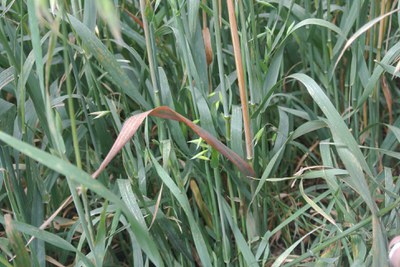
A
|
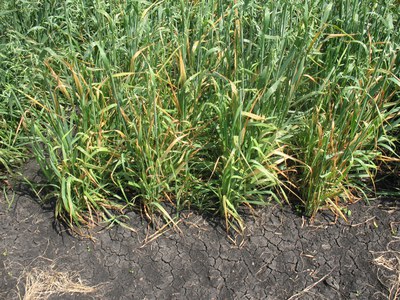
B
|
Figure 3. Symptoms of barley yellow dwarf. (A) Reddening of leaf tip. (B) Yellowing of leaf tips and stunting of plants. (Mike McMullen, NDSU)
Harvesting and Storage of Oats for Grain
To avoid losses from shattering, oats usually are swathed and threshed by a combine with a pickup attachment. Swathing of oats should commence when the kernel moisture content is about 35 percent. This is usually when the panicle has turned yellow or brown, even though some stems still may show some green, and the least mature kernels have changed from green to cream.
The swathed oats should be threshed as soon as they reach an appropriate moisture. Oats that are left too long in the field can weather and may not be acceptable for premium markets.
Combine settings should be slower and the concave wider than those used for other small grains to avoid dehulling kernels. Hull-less oat varieties are more susceptible to kernel damage, so cylinder speeds should be reduced to approximately 900 revolutions per minute to prevent damage.
Oat grain should be dried to at least 14 percent moisture before storage and to 12 percent moisture for long-term storage.
Growing Oats for Forage
Growing oats for forage requires many of the same management factors as growing oats for grain. Variety selection is one area to consider. The forage quality and yield of oat varieties are evaluated from time to time. Forage quality generally is greatest from the late-maturing cultivars.
Naked oat varieties also have been used commonly for forage production due to their higher forage quality. Their yield may not be as high as some nonhull-less varieties, however. Unfortunately, most available oat varieties have not been tested for forage quality.
The maturity stage at which oats should be harvested for forage varies with the type of livestock to be fed. Oats should be harvested at the soft-dough stage when fed to a cow-calf herd to maximize digestible dry matter per acre.
If oats are harvested too late, the digestibility of the fiber and palatability decrease and mature kernels may shatter during the baling operation. Late-boot stage harvest is recommended when the forage is to be used in a dairy ration to help meet the high protein demands of the dairy cow.
Oats used as forage generally are put up as hay in North Dakota, but occasionally they are harvested as a haylage or for silage. The maturity stage for haylage should be the same as for hay.
The primary problem with obtaining good-quality haylage is controlling the moisture content when ensiling. Oats at the soft-dough stage will have from 25 to 35 percent dry matter, depending on the environment. Good moisture for ensiling is 60 to 70 percent.
However, haylage should have 45 to 50 percent dry matter for good ensiling, so some wilting will be required. Be careful not to lay down too much at one time or controlling the ensiling moisture content will be difficult.
Field pea/oat mixtures sometimes are used to increase hay quality. If peas are included, the seeding rate of oats should be decreased about 20 to 30 percent to allow some space for the peas. Typically, 40 to 60 pounds of peas are seeded per acre.
Pea/oat mixtures generally result in yields that are similar to or slightly less than for pure oat stands. Including peas increases the crude protein content about 1.5 percent but does not otherwise increase digestibility or reduce fiber content.
Useful Internet Resources
Information on variety performance and characteristics:
General production information
Certified Seed Catalog for North Dakota
This publication was authored by Michael McMullen, NDSU oat breeder, and William S. Ball, former NDSU Extension agronomist, in 1986. It was revised by McMullen; Joel Ransom, NDSU Extension agronomist; and Dwain Meyer, former NDSU forage specialist, in 2007.

Revised September 2018
